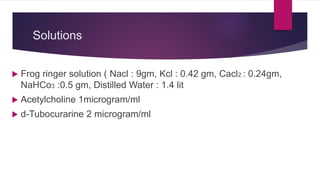Practicals 4 ugs
- 1. Effect Of Eserine On The Action Of Acetyl Choline On Frog Rectus Muscle
- 2. Aim ? To determine the action of eserine on the action of Acetyl Choline on the frog rectus
- 3. Apparatus ? Recording Drum or Kymograph ? Stand with lever ? Bent glass tube ? Frog dissection instruments
- 4. Procedure ? A pitched frog dissected and rectus abdominis exposed ? Lower end is fastened to bent glass tube ? Muscle immersed in beaker containing ringer ? Two normal contractions are recorded with interval of 3 min ? Eserine is added to medium and amplitude of contraction is observed
- 5. Observation ? Observations are recorded on recording drum and interpreted
- 6. Inference ? Eserine potentiates the effect of Acetylcholine on muscle ? It inhibits both true and pseudo cholinesterase ? Causes accumulation of choline at motor end plate and hence increased amplitude of contraction
- 7. Effect Of d-Tubocurarine On The Action Of Acetyl Choline On Frog Rectus Muscle
- 8. Aim ? To know the effects of d-Tubocurarine on Acetylcholine contractions of frog rectus muscle
- 9. Apparatus ? Kymograph or Recording drum ? Frog dissection instruments ? Oxygen tube ? Aerator ? Simple lever
- 10. Solutions ? Frog ringer solution ( Nacl : 9gm, Kcl : 0.42 gm, Cacl2 : 0.24gm, NaHCo3 :0.5 gm, Distilled Water : 1.4 lit ? Acetylcholine 1microgram/ml ? d-Tubocurarine 2 microgram/ml
- 11. Dissection ? A pitched frog is laid on a plate. ? Skin of the abdominal wall is cut and open. ? Identify the horizontal ladder like fibrous bands of rectus abdominis muscle. ? Separate both muscles from the abdominal wall. ? Pass threads underneath the muscle. ? Tie the upper ends and lower ends.
- 12. ? Swipe off the upper end with a piece of xiphisternum and lower end with pubic attachment. ? The muscle with threads is kept in a beaker with lower end is tied to the oxygen tube and upper end to the simple lever. ? It has a counter weight or load of 1.4gm using plasticine. ? A beaker of ringer solution is kept under the oxygen tube and oxygen is allowed to pass. ? Leave the preparation for half an hour. ? Put sufficient load so that the contractions will be able to raise the lever Dissection
- 13. Procedure ? The drum is started and is allowed to rotate for 15 sec ? After 15 sec, the ringer solution is changed with Acetylcholine solution. ? After 90 sec, it is replaced with frog ringer solution. ? The muscle that contracts during Ach exposure, slowly relaxes and comes to original position ? Repeat the process until you get equal contractions with Ach. ? Now immerse the muscle in d-Tc solution for 30 sec ? Replace with Ach and repeat contractions ? If 10 micrograms of d-Tc is given, complete depression of Ach contraction is seen
- 14. Observation ? Stimulatory action of Ach on rectus abdominis muscle ? Blocking action of curare or d-Tc on Ach induced contractions of rectus muscle














